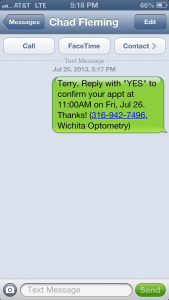“How is your practice going?”
“Great! In fact, we’re booked solid for the next six weeks.”
This conversation (or similar versions) between optometrists can be overheard numerous times at any continuing education event. But while a full schedule may indicate a successful practice, the real test is the actual number of patients who show up at their appointed times. Many practices can boast a full schedule, but can they back that up with a no-show rate under five percent?
Here are three key areas to focus on to keep the no-show rate low.
- Effective Communication – Not all new technology is beneficial for the practice. If not used carefully, it can even be detrimental. For example, our office recently implemented a communication software called SolutionReach (aka – Smile Reminder). Many of our patients tell us they love this new addition. When we set it up, we decided to continue to have an actual staff member calling patients for the one-month confirmation. What we noticed is that patients who had only supplied us with their land line number would receive the recorded SolutionReach with an initial pause before the
 message. The problem is the patient assumes the call is from a telemarketer and hangs up. When we checked our data, we found the few no-shows we had were patients who only used a land line.
message. The problem is the patient assumes the call is from a telemarketer and hangs up. When we checked our data, we found the few no-shows we had were patients who only used a land line. - Confirmations – Whether your practice does one-month, one-week, or one-day confirmation calls, texts, or emails, confirmation is a must to keep your no-show rate below five percent. An effective way to do this is to touch base with the patient through a SolutionReach or DemandForce software. A simple phone call also works effectively. If a patient sets an appointment a year in advance, a staff member calls the patient one month before to confirm the appointment. At that time it allows the patient to reschedule if necessary. A few days before the appointment, the patient is contacted again either by phone, text, or email. Our office has found two or three days before is most effective as this gives patients time to adjust their schedules if they have forgotten about the appointments.
- Tracking System – An accurate system to track why patients are canceling appointments and–most importantly–not showing up for appointments is
 key to making effective changes that decrease the number of no-shows. To do this, a staff member reviews the schedule at the end of the day and notes any no-shows. Then the staff member assesses how the patients were notified of their appointments and if the patients had confirmed prior. By doing this a practice can pinpoint the most effective means of confirming patients for their appointments. Software such as the SolutionReach or DemandForce make this much easier.
key to making effective changes that decrease the number of no-shows. To do this, a staff member reviews the schedule at the end of the day and notes any no-shows. Then the staff member assesses how the patients were notified of their appointments and if the patients had confirmed prior. By doing this a practice can pinpoint the most effective means of confirming patients for their appointments. Software such as the SolutionReach or DemandForce make this much easier.
To have a low no-show rate does not require an optometry office to utilize a SolutionReach or DemandForce. A low no-show rate can be accomplished by various means of communication and software or staff. The key is to isolate the no-shows and determine where the disconnect is between the office and the patient. The cost of a no-show is too much to pay when the margins for profit are continually being reduced.





